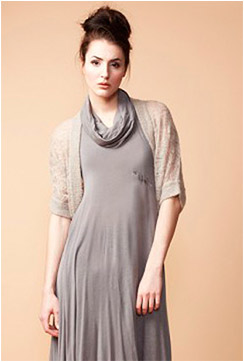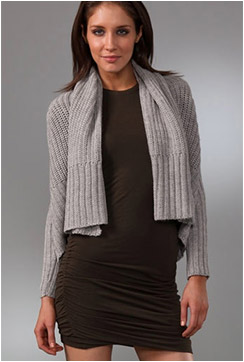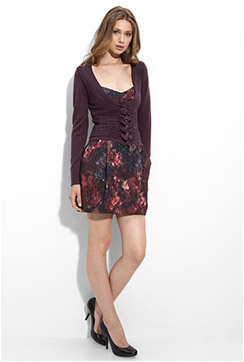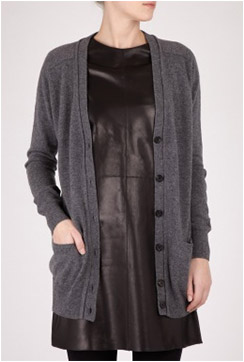In an effort to wear our frocks into Autumn and Winter, we’ve discussed layering under dresses and layering jackets over dresses. Today I complete the series by addressing how to layer cardigans over dresses.
I often hear from my clients and forum members that wearing cardigans over dresses makes them feel dowdy. I understand this completely and admit that achieving a hip combination between dress and cardigan is tricky for several reasons. But don’t give up yet! These guidelines might help as you shop your closet.
First, some things to bear in mind:
- Consider layering with ALL cardigan silhouettes. Cropped, hip length, cocoon, tunic, boyfriend, cascading, fly-away, waterfall, round bottomed, shrug, bolero, vest, chunky – and anything else. You might strike up a fabulous outfit just by experimenting with an atypical combination.
- Layering sleeved cardigans over sleeveless dresses works best because it prevents uncomfortable, lumpy bulk on the arms.
- Layering sleeveless cardigans over sleeved dresses works well too. No sleeve bunching.
- V-neck cardigans and cardigans that don’t fasten tend to layer quite easily since they seldom interfere with the neckline of the dress.
- Sometimes it’s not just about marrying the right dress and cardigan silhouette, but also about creating the right level of colour contrast between the two layers. A low contrast tends to work more often than a high contrast.
- A dress with a hemline above the knee will feel instantly less dowdy when paired with a cardigan.
When in doubt about how to achieve the right combination of dress and cardigan, try one of two things:
- Add a waist cinching belt on top of the cardigan, or…
- Leave the cardigan unbuttoned and unbelted to create a flattering vertical line down the front of the body (wearing a cardigan open can work wonders).
Here are some guidelines for pairing the style of the dress with the silhouette of the cardigan. These are not rules, but they are a good place to start.
- Sheath dress: Cardigans layer exceptionally well over short, form fitting sleeveless sheath dresses, so try anything from tunic boyfriend, cocoon, boxy and cascading styles, to shrugs, classic cropped and round bottomed styles. Feel dowdy? Add a belt over the cardigan and keep the cardigan unbuttoned. For a fuller bust I tend to prefer a fine gauge unbelted and unbuttoned tunic cardigan layered loosely over a sheath dress.
- Sack dress: You really only have two options here. (1) Layer over a very short shrug/bolero or cropped cardigan leaving it unbuttoned, or (2) layer over an unbuttoned and unbelted tunic cardigan (boyfriend or cascading) that is almost as long as the dress.
- Fit and flare dress: Layer over a short snug shrug, or layer over a hip-length cardigan worn loose or belted at the waist. A shrug won’t interfere with the line of the dress while the belted hip-length cardigan option follows the shape of the dress.
- A-line dress: These are hard to layer with anything but a loose, long cascading cardigan style.
- Empire cut dress: I like a sleeved empire cut dress layered with a sleeveless tunic cardigan. And long boyfriend cardigans look cute over short empire dress styles too.
These pictures show interesting layered dress and cardigan ensembles. In case you’re wondering about shrugs, they needn’t be tight and extra short. Shrugs come in more relaxed silhouettes as seen in the first photo. The second photo shows a short boxy cardigan layered over the most versatile of dress layering options: a form fitting sheath (although the hemline needn’t be as short as the one pictured). The third photo shows a buttoned up classic shape cardigan worn over a fit and slightly flared dress. The last photo shows a short A-line, almost sack-like dress with a loosely worn boyfriend cardigan – definitely a more arty option. The short hemline is key to making this combination work.
Lots of variables to think about here. Do these guidelines make sense? Do you think you can get past feeling like Aunt Mildred when layering a cardigan over a dress? If you have further questions, please ask away in the comments below.













